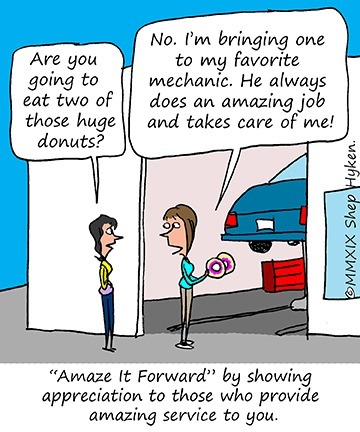Shep Hyken's Blog, page 130
March 18, 2019
5 Top Customer Service Articles for the Week of March 18, 2019
Each week I read a number of customer service and customer experience articles from various resources. Here are my top five picks from last week. I have added my comment about each article and would like to hear what you think too.
10 Tips to Build a Customer Centric Work Culture by Vandita Grover
(MarTech Advisor) We list 10 customer experience (CX) tips that will establish customer centricity as the core philosophy of your organization and help create a customer-focused environment across your company.
My Comment: Consistent accolades about a company’s customer service and experience don’t happen by accident. It’s most likely a function of the company’s culture. When I speak at conferences in front of an organization’s leadership, I’m almost always asked about how to build the customer-focused culture. Here’s some sound ideas that will help you on that journey.
Why Omnichannel is the Future of Customer Interactions (And How You Can Get Started) by Josh Brown
(B2Community) Give your customers the seamless, expertly integrated buying experience they expect and your company becomes the real winner.
My Comment: The technical term “omnichannel” is really about a customer being able to connect with a company through any means they desire; phone, social media, messaging, etc. This article shares wisdom on the importance of an omnichannel strategy. Just know that the customer probably has never heard the word “omnichannel” before. All they care about is an easy way to get to the company they do business with. This article has plenty of information, stats and facts to get you thinking.
Improving NPS for a Better Customer Experience by Kathy Doering
(CustomerThink) Quality Assurance in the contact center is being used to improve NPS (Net Promoter Score) and overall customer experience
My Comment: If you’ve read my work and these weekly roundups, then you know that I’m a fan of the NPS survey. It’s one thing to implement the survey to get feedback. It’s another to properly use that feedback. And, that’s what this article is about.
CX in 2019: Top Customer Experience Trends to Keep on Your Radar by Gavin James
(Beyond The Arc) Based on our years helping companies with customer experience strategy and communications, the Beyond the Arc team shared insights on some top trends to keep on your radar this year
My Comment: It doesn’t hurt to be reminded of important trends in the customer service and CX world. While we’ve seen many of these before, I want to emphasize (and so does the article) the concept of focusing on the EX, which is the employee experience.
Leverage AI To Remove Friction From The Customer Service Experience by Puneet Mehta
(Forbes) Customer service could pose the biggest threat to companies in today’s consumer-centric culture.
My Comment: You can’t ignore the importance and improvements in the world of AI in customer service. Here’s a short article on ways that AI can remove friction from the customer’s experience. Note that as good as AI is (It’s much better than a year ago, and will be better a year from now.), you must be sure to have a seamless switch to a human support agent to back up the technology.
Shep Hyken is a customer service expert, professional speaker and New York Times bestselling business author. For information on The Customer Focus customer service training programs go to www.TheCustomerFocus.com. Follow on Twitter: @Hyken
customer service training programs go to www.TheCustomerFocus.com. Follow on Twitter: @Hyken
The post 5 Top Customer Service Articles for the Week of March 18, 2019 appeared first on Shep Hyken.
March 15, 2019
Guest Blog: Why Facilities Managers Are the Hidden Heroes of Great Customer Service
This week we feature an article by Tom Buiocchi who writes about the importance of the “behind the scenes” work facilities managers do in order to enhance the customer experience. – Shep Hyken
When you think about how to provide excellent customer service, chances are facilities management might not be the first thing that comes to mind. This isn’t terribly surprising, given the work facilities managers do have been traditionally considered “behind the scenes” of the retail experience.
However, digital transformation has changed the game on who is responsible for delivering customer service and how. It’s all part of the critical need to deliver an overall positive retail customer experience that gives shoppers a reason to come into the stores instead of just surfing online. And when it comes to servicing customers well in any store, it begins with a warm, well-lit, safe, and welcoming facility.
So, all those “behind the scenes” work the facilities managers do – making sure all equipment is functioning properly, keeping stores clean, handling weather-related emergencies, managing contract workers, ensuring store security– is actually at the forefront as part of the customer experience. The goal is for all retail stores to maintain the highest levels of brand uptime, which directly correlates the state of a facility with the experience any brand wants its customers to experience.
3 Ways to Support Excellent Customer Service from Behind the Scenes
There are three major ways to enhance customer experience and service through strategically managing your facilities:
1. Keep Up Appearances
It’s no secret that the Internet has reshaped the in-store shopping experience; where the physical store was once the only way to interact with a brand, now the role of brick and mortar store has morphed into a “showroom”, or a way for businesses to connect with consumers through experiences and amenities. This puts an even greater emphasis on store appearance. Stores must be clean, visuals like decorations, mirrors, shelving, and installations must be kept in top condition, and equipment like registers, HVAC units, and lights must be fully functional.
FMs do the work that makes all of this possible, like monitoring store conditions, managing all of the repair and maintenance work that keeps things in tip-top shape and tracking everything’s repair histories and warranties. Facilities managers are always looking ahead so that instead of reacting when things go wrong, they anticipate potential issues and address them before customers can even begin to notice. The result? Customers never experience burnt-out lights, snow-covered entranceways, broken air conditioning, dirty floors, or tumbling decorations, leaving them with only positive in-store experiences.
For businesses that have more than one location, consistency is another key aspect of customer service. Chain brands need to standardize customer experiences across locations; the look and feel of stores should be the same no matter which one a customer visits. Centralizing facilities management operations can help ensure this consistency.
2. Turn the Focus Back to Customers
Often, retail businesses don’t have specialized facilities managers. Instead, they rely on individual store managers to handle repairs and maintenance, in addition to their regular duties. This can cause a number of issues because of the time-consuming nature of these tasks. The result is that store managers have significantly less time to focus on customers.
Implementing automation software that takes care of scheduling repairs on its own, as well as hiring experienced team members dedicated to FM, can free store managers from in-the-weeds facilities work and give them back the time and resources they need to give customers the best possible service.
3. Optimize Customer Flows
Strategic use of space is key to creating great in-store customer experiences; how and where amenities like dressing rooms, services such as cash registers, and products are situated within stores affects what customers see, how they move, and whether or not employees can serve them properly. Poor space planning can lead to negative consequences like crowds that block easy access to products and long lines that customers have to wait in to pay.
Facilities managers should be involved in space planning because they have unique perspectives and expertise in equipment and assets. They can ensure that assets both internal— pipes, wires, and ducts— and customer-facing— registers, shelves, tables— are strategically located so that they create smooth customer movements.
Additionally, FMs can oversee space optimization initiatives like moving shelving or updating displays, which are especially important for creating special customer experiences during times like the holiday season. It’s facilities managers’ jobs to execute space changes during off-hours to minimize any impacts on customer experience.
Final Thoughts
Businesses are now competing in a marketplace where customer expectations are elevated. It’s no longer enough to just present products anymore; stores have to create in-store experiences that delight shoppers in order to earn their business. To be successful, companies need to maximize their stores’ potential and use in-store experiences to set themselves apart from the pack. Don’t sleep on facilities management, since it can be the difference between delighting customers in-store and driving them away.
 Tom Buiocchi joined ServiceChannel as an Executive Director in 2014. Tom has more than 30 years of experience leading growth companies in both technology and energy services, including Drobo (CEO), Brocade Communications (CMO), Rhapsody Networks (VP Marketing), FMES (co-founder and COO), and Hewlett-Packard.
Tom Buiocchi joined ServiceChannel as an Executive Director in 2014. Tom has more than 30 years of experience leading growth companies in both technology and energy services, including Drobo (CEO), Brocade Communications (CMO), Rhapsody Networks (VP Marketing), FMES (co-founder and COO), and Hewlett-Packard.
For more articles from Shep Hyken and his guest contributors go to customerserviceblog.com.
Read Shep’s latest Forbes article: The Other “E” In Customer Experience: Customer Effort
The post Guest Blog: Why Facilities Managers Are the Hidden Heroes of Great Customer Service appeared first on Shep Hyken.
March 13, 2019
Amaze It Forward
 You’ve heard of the concept of Pay It Forward. Many people use the phrase to describe doing a good deed for someone with no other expectation than that person doing something nice for someone else and so on, creating a chain of good deeds. Don’t pay it back. Pay it forward.
You’ve heard of the concept of Pay It Forward. Many people use the phrase to describe doing a good deed for someone with no other expectation than that person doing something nice for someone else and so on, creating a chain of good deeds. Don’t pay it back. Pay it forward.
Some people don’t realize that the Pay It Forward movement was started by a movie of the same name, which was based on a book by Catherine Ryan Hyde. A seventh-grade social studies teacher gives his class an assignment to come up with an idea that could change the world. Trevor, one of the students, comes up with the idea that if you do a favor for three people and each of those people did a favor for three more people and it continues, then it’s just a matter of time before it would spread across the whole world.
That brings us to my friend Dave Simon, former owner of Dave Simon’s Rock School, who’s taught thousands of kids how to play music and perform in a band. He emailed me the other day with an idea that he referred to as “Amaze it Forward.”
Not too long ago, Dave went to the dry cleaner to pick up his laundry. He planned to stop by the Starbucks next door after picking up his clothes. As the owner of the store handed him his change, Dave thought about what he calls “doing a Shep Hyken in reverse.” Dave asked, “Can I get you a coffee from Starbucks?”
The owner was flabbergasted by his kind offer and uttered, “Uh, uh… sure. I’ll have a Café Americano!” He was so moved to have someone he served offer to serve him.
We love when we receive amazing service, and I’m sure we all strive to provide an amazing service experience for our customers. Dave’s idea is to do something amazing for the people who serve you – the people who don’t expect you do to anything in return other than paying them for what they sell.
One of our Shepard Letter subscribers, Jeff Scott, wrote in with a similar example. He was staying at a nice hotel in Japan. Before his departure, he wrote a thank you note in Japanese, using Kanji characters, and left it with a box of chocolates. Jeff said of his gesture, “Trying to practice being amazing, even when I’m the customer!”
The next time someone gives you an amazing service experience, Amaze It Forward by doing something nice for them. It could be a cup of coffee, a gift card, or anything that will make them smile. When they thank you, let them know how much you appreciate them and that you hope that they will do the same for someone who is amazing to them. Being nice to others means they will be nice to you. Amazement works both ways!
Shep Hyken is a customer service expert, keynote speaker, and New York Times bestselling business author. For information, contact 314-692-2200 or www.hyken.com. For information on The Customer Focus customer service training programs, go to www.thecustomerfocus.com. Follow on Twitter: @Hyken
customer service training programs, go to www.thecustomerfocus.com. Follow on Twitter: @Hyken
The post Amaze It Forward appeared first on Shep Hyken.
March 12, 2019
Amazing Business Radio: Todd Hopkins
 Core Values and Company Culture
Core Values and Company CultureCulture, Commitment, and Taking Care of Customers
Shep Hyken interviews Todd Hopkins. They discuss how having a company-wide culture can lead to better customer service and success for your business.








In Shep’s Opening Monologue…
He talks about what you should do with customer feedback once you get it.
The Interview with Todd Hopkins:
Core values can work as a filter to influence every decision you and your employees make. When faced with a difficult situation, employees can think about the core values and compare them to possible courses of action to determine what will best uphold the company’s values.
When a company has a set of core values, the entire organization can align itself together. This allows employees to create a better experience for their customers.
To motivate your employees, find out what their dreams and goals are. Help them connect the dots between those dreams and job they have with you, and passion and motivation will follow naturally. Integrate that human connection and you will create loyal, hardworking employees.
Establish an upfront agreement with both employees and customers that allows for future feedback free from emotion. This helps customers feel comfortable submitting feedback and allows you to have honest conversations with your employees to fix problems without worrying about hurt feelings. The more honest communication you can have inside and outside of your organization, the better.
Aim to be better than satisfactory on a consistent basis. That’s how you create amazing experiences, both for your customers and for your employees.
Quotes:
“I like to hire people that come to us with batteries included.” – Todd Hopkins
“Connect the dots between the dreams your employees are trying to accomplish and the job they have with you. That contributes to their motivation.” – Todd Hopkins
“If we want to take good care of our customers, we have to take good care of our employees.” – Todd Hopkins
“People don’t want to be average. They really want to be amazing.” – Todd Hopkins
About:
Todd Hopkins is the founder and CEO of Office Pride Commercial Cleaning Services, which has over 130 franchise locations in 24 states. He is also the internationally best-selling author and co-author of four books.
Shep Hyken is a customer service and experience expert, New York Times bestselling author, award-winning keynote speaker, and your host of Amazing Business Radio.
This episode of Amazing Business Radio with Shep Hyken answers the following questions … and more:
What is a culture book?
What should I do with customer feedback?
How do I hire the right people for my company?
How can I get more customer feedback?
How can I motivate my employees?
The post Amazing Business Radio: Todd Hopkins appeared first on Shep Hyken.
March 11, 2019
5 Top Customer Service Articles for the Week of March 11, 2019
Each week I read a number of customer service and customer experience articles from various resources. Here are my top five picks from last week. I have added my comment about each article and would like to hear what you think too.
5 Ways AI can Revolutionize Customer Experience by Vandita Grover
(MarTech Advisor) Customer Experience (CX) is a competitive differentiator and driving force for a business’ success. For marketers, it is important to explore powerful opportunities that can drive improved customer engagement and interactions.
My Comment: If you’ve ever asked the question, “How AI can impact the customer experience?” then this article will give you the five best answers. Good basic information with excellent examples of how AI is changing the way we do business.
Five Negotiation Strategies When Traditional Customer Service Fails by Chris Westfall
(Forbes) When engaging in a difficult dialogue, it’s easy to see the adversarial relationship between two parties. There’s the company’s viewpoint and the customer’s viewpoint. But what about a counterpoint?
My Comment: What do you do when a customer’s complaint gets escalated to a level beyond support or a social thrashing on a social media channel. Here are five ways strategies to help you go from rants and threats to a resolution.
Keep the Customer Satisfied: 4 Tried and True Service Guidelines by Susan Steinbrecher
(Inc.) An outstanding product or service is not enough to attract — and maintain loyalty.
My Comment: What if the word HELP was an acronym, where H meant Hear the customer out, E stood for Empathy, L meant Leading the customer to a resolution and P was about Providing the right course of action. That’s what Susan Steinbrecher came up with in this short article about how to resolve customer complaints and problems.
Spark Customer Experience Innovation With These Three Strategies by Denise Lee Yohn
(Forbes) Even if you know that innovation in CX is the primary way to compete and win today, you might not know how to get started. Here are three strategies to spark CX innovation.
My Comment: This short article focuses on CX innovation. One of the powerful ideas the author shares is about CX training for the entire organization. Spot on! I believe that CX, like customer service, isn’t a department. It’s a philosophy to be embraced by everyone in an organization. It’s in the culture of a company.
Happiness at Work: Workplace as a Source of Happy Life by Gennady Shkliarevsky
(International Policy Digest) Until relatively recently happiness was not an important factor in our corporate culture. The main concerns of business owners, managers and economists were generally about profits, supply and demand, efficiency, productivity and such like. Happiness rarely, if at all, entered into consideration as a category operational in a business environment.
My Comment: Happy employees are engaged employees. At least that’s a common belief, and I won’t argue with it. This article goes into detail about the importance of workplace happiness. What’s happening on the inside of an organization is felt on the outside by the customers. Taking care of employees – as in making them happy at work – is crucial to the success of a customer service and experience strategy.
Shep Hyken is a customer service expert, professional speaker and New York Times bestselling business author. For information on The Customer Focus customer service training programs go to www.TheCustomerFocus.com. Follow on Twitter: @Hyken
customer service training programs go to www.TheCustomerFocus.com. Follow on Twitter: @Hyken
The post 5 Top Customer Service Articles for the Week of March 11, 2019 appeared first on Shep Hyken.
March 8, 2019
Guest Blog: 3 Ridiculously Simple Ways to Generate Customer Delight
This week we feature an article by Jason Milleisen who shares three simple rules that will set you apart from your competition and help provide great customer service. – Shep Hyken
 I once heard about a car dealership who had customer satisfaction scores that were the impressively high. When asked about it, the owner explained one of the secrets to their success.
I once heard about a car dealership who had customer satisfaction scores that were the impressively high. When asked about it, the owner explained one of the secrets to their success.
Every once in a while, they’d send out a car knowing there was a slight problem with it. You read that correctly. They let cars leave the lot with a defect on purpose. A missing knob, a dirty floor mat, things like that. Then, when the buyer reported the problem, the dealership sprang into action.
With lightning quick speed, the dealership offered to have someone come pick up the car, make the needed repair, then swiftly return it to the buyer. They’d also throw in a free oil change and car wash to apologize for the inconvenience
While I’d certainly not advocate this kind of tactic, it highlights an important lesson that every small business owner needs to understand about customer service: a customer with a problem is an opportunity to leave a lasting, positive impression.
Let’s talk about 3 simple (yet powerfully effective) rules that will set you apart amid a sea of cranky reps, unreturned emails, and just plain bad customer service.
Remember The Golden Rule
We all learned this one a long time ago. Treat others how you’d like to be treated. Easy enough. Yet many businesses, even the really large ones, seem to forget the golden rule on a regular basis. I’m looking at you AT&T. They owed me a refund of $920, and it took 10 separate phone calls to get my money back. Would any person on earth want to be treated like that? Of course not!
And it’s not just large businesses who forget the golden rule.
We went out to dinner a few weeks back for my brother’s birthday. Our reservation was for 7:30 pm. Our entrees came out at 9:45 pm. By that time, it was clear that we were tired, hungry, and frustrated. When the kitchen is backed up, it’s not the servers fault. Nonetheless, she was the face of the restaurant, so it was her job at that moment to find a way to make it right.
If you run a business for long enough, situations like that birthday dinner are bound to happen. That’s life. But as small business owners, we should recognize that a customer with a problem is an opportunity to send a clear message: I hear you, I’m sorry this happened, and I’m going to make it right.
Unfortunately, on that night, the server chose to ignore the problem, and when we skipped dessert (that was included with our meal) she didn’t even offer to pack them up to go. As a result, I’ll never go back to that restaurant. Why? Not because the kitchen was slow that night. It’s because they made no attempt to make it right. Give me a free appetizer, or take a drink off the bill. Do something. Do anything to show me that you are sorry that your customer had a bad experience. Otherwise, I’ll assume you don’t care if I come back or not.
Under-Promise and Over-Deliver
If you understand how to properly manage customer expectations, you will eliminate that angry phone call that nobody wants to get from an unhappy client. I practice the art of under-promising and over-delivering on a daily basis, and I can tell you first-hand that it yields amazing results.
Setting expectations is a powerful, yet overlooked tool that you can use to craft your customer’s perception of your business. I always say that despite my inability to do anything handy, I should go into the home improvement business. Why? Because any home improvement project I’ve ever hired for inevitably runs over budget on both time and money. Nothing makes me more annoyed than the 2 week project that runs 6 weeks. A simple solution to this issue? Tell me it’ll take 8 weeks, then finish it in 6. You’ll be a hero! Instead, you’re just another guy who talks a good game but can’t deliver.
I can hear you yelling at your screen already: But what about in a competitive situation? I need that customer so I need to be aggressive!
I get it. You are competing for customers, and in the midst of that, you want to promise the customer something that the competition can’t (or won’t). I’m not saying you shouldn’t try to be better than the competition. What I am saying is that when you make promises that you can’t keep, you’ll end up driving your customers into the arms of your competitors when you fail to deliver on your promises.
Embrace Your Size
I run a consulting shop that employs one person: me. I use that to my advantage, and you should too.
When a prospective customer calls me for a consultation, I make sure they know that I’m the only one who will handle their file, and it will never be passed off to someone else. Is there anyone else who could handle their file? Nope. But that doesn’t mean there isn’t value in me handling each and every full personally.
Small businesses often strive to appear to be a much larger organization than they actually are. “Fake it till you make it!” is the credo. In some cases, that makes total sense. You don’t want, for example, customers to know that your high-end shoe site is actually a drop-shipping operation run from your bedroom.
On the other hand, being small can be a selling point for you like it is for me. Have you ever sat on hold with the cable company for an hour, only to have a completely incompetent representative muck it up even further? Makes your blood boil, right? And therein lies the opportunity.
Embrace being a real person on the other end the phone that has the ability to resolve their problem quickly and cheerfully.
Who would you rather deal with? The generic customer service person, or Steve, Founder and Owner of ShoeCity.com. Do you know what Steve can do that nameless, faceless customer service reps can’t do? Steve can respond to urgent customer emails after business hours, and take phones call on a Sunday even though the business is technically closed. Nothing like that is going to happen at Amazon. Use that to your advantage.
Jason Milleisen is founder and owner of Distressed Loan Advisors, a consulting firm that assists small business owners who are facing SBA loan default and wish to pursue an SBA Offer In Compromise.
For more articles from Shep Hyken and his guest contributors go to customerserviceblog.com.
Read Shep’s latest Forbes article: Ritz-Carlton Founder Reveals Secrets For Success
The post Guest Blog: 3 Ridiculously Simple Ways to Generate Customer Delight appeared first on Shep Hyken.
March 6, 2019
Look Past the Obvious for a Better Solution
 Winter travel can be stressful with the concern of weather-related delays and cancellations. On a recent trip that had a connecting flight, I was notified the night before that my first flight was going to be delayed, which made me worry about missing my connection. I called the airlines and they suggested changing my connecting flight to a later one, which I was happy to do. Even though the flight was later, I would still arrive in time for my meeting. The customer service agent was happy to accommodate my request.
Winter travel can be stressful with the concern of weather-related delays and cancellations. On a recent trip that had a connecting flight, I was notified the night before that my first flight was going to be delayed, which made me worry about missing my connection. I called the airlines and they suggested changing my connecting flight to a later one, which I was happy to do. Even though the flight was later, I would still arrive in time for my meeting. The customer service agent was happy to accommodate my request.
Then I started to think. She rebooked me on the later flight. I wondered if there was an earlier flight from my home airport that would allow me to keep my original connecting flight. Sure enough, there was. I called the airline back and, once again, they were happy to accommodate my request.
Here’s the point of the story. I shouldn’t have had to call back. The agent should have offered me the option of leaving on the earlier flight. She was very nice and willing to help. But she didn’t look past the obvious, which was to check on a later flight. Given that I called hours before the flight, she might have looked at the earlier flight, which was actually a better option.
This may sound like I’m criticizing her and I guess, in a way, I am. But, not about the way she treated me. She was a model customer service agent; friendly and helpful. However, the reality is that she should have thought to give me the option of taking the earlier flight. Proper training and coaching could have helped. I’m sure that if I had suggested looking at earlier flights she would have said, “Good idea.”
How many times do we find a solution to a problem and stop considering other options, potentially missing a better solution? After the fact you think, “Darn, I should have thought of that!”
One way to come up with an alternative solution is to think about the opposite. In our airline example, what would have happened if the agent asked herself, “What’s the opposite of being switched to a later flight?” The answer, of course, is an earlier flight. Then check to see if there is one.
Opposite thinking is just one way to get into creative problem solving. There are many others. The point is that if you’re working with a customer and trying to resolve a problem, consider all potential solutions, not just the first one you come up with. Even if the first one you think of turns out to be the best solution, you would know that you gave yourself and the customer other options to consider.
Shep Hyken is a customer service expert, keynote speaker, and New York Times bestselling business author. For information, contact 314-692-2200 or www.hyken.com. For information on The Customer Focus customer service training programs, go to www.thecustomerfocus.com. Follow on Twitter: @Hyken
customer service training programs, go to www.thecustomerfocus.com. Follow on Twitter: @Hyken
The post Look Past the Obvious for a Better Solution appeared first on Shep Hyken.
March 5, 2019
Amazing Business Radio: Horst Schulze

Excellent Decisions from the Cofounder of the Ritz-Carlton
Aligning Your Organization to a Company-wide Culture
Shep Hyken interviews Horst Schulze, the cofounder and COO of Ritz-Carlton Hotel Company. They discuss Schulze’s new book, Excellence Wins, and how he succeeded in creating one of the best hotel companies in the world by developing and sustaining a culture of excellence.








In Shep’s Opening Monologue…
He discusses the importance of creating a customer-focused company culture and how to go about it.
The Interview with Horst Schulze:
Schulze shares the story behind the famous The Ritz-Carlton Credo, which is “We are ladies and gentleman serving ladies and gentlemen.”
There are three things customers want regardless of the industry that form the foundation of every customer interaction. Schulze calls these the Three Universals, and they are a flawless product, timeliness, and kindness.
The most important of the Three Universals is kindness. Customers may forgive you for minor flaws in the product if you are nice to them. However, they will not forgive you if you are unkind, even if the product is flawless.
The next step is to individualize and personalize the Three Universals to each and every customer. Bringing this human connection into the customer experience is what creates above average and excellent customer service and ensures customer loyalty.
If you take pride in what you do and always strive for excellence, you will not only create excellence, but earn the respect of your colleagues and your customers.
It’s crucial to get every employee into alignment on the standards and mission of your company. This begins with the initial onboarding process and continues every single workday; training must always continue to ensure alignment and company prosperity.
You should not simply “hire” employees; you should instead select individuals who you are a good fit for your culture and the specific role within the larger organization. Selecting the best possible people for each position will ensure success for your company.
Everything you do in life is a decision. Actively decide to be excellent and pursue it relentlessly.
Quotes:
“You can define yourself as excellent if you create excellence, no matter what your job is.” – Horst Schulze
“The greatest driver of customer satisfaction is to be nice.” – Horst Schulze
“We are here to serve, but we are not servants.” – Horst Schulze
“If you don’t keep on training, sooner or later somebody will better than you are.” – Horst Schulze
“Everything you do in life is a decision. Decide to be excellent.” – Horst Schulze
About:
Horst Schulze is the founder, chairman, and CEO of the Capella Hotel Group and co-founder and former COO of the Ritz-Carlton Hotel Company. He is also a highly sought after keynote speaker and renowned business leader.
Shep Hyken is a customer service and experience expert, New York Times bestselling author, award-winning keynote speaker, and your host of Amazing Business Radio.
This episode of Amazing Business Radio with Shep Hyken answers the following questions … and more:
How can I create a customer-focused culture?
How can I hire the best employees?
What’s the best way to satisfy my customers?
How can I define my company’s culture?
How should I train my employees?
The post Amazing Business Radio: Horst Schulze appeared first on Shep Hyken.
March 3, 2019
5 Top Customer Service Articles for the Week of March 4, 2019
Each week I read a number of customer service and customer experience articles from various resources. Here are my top five picks from last week. I have added my comment about each article and would like to hear what you think too.
Why Is Customer Service So Bad? Because It’s Profitable. by Anthony Dukes and Yi Zhu
(Harvard Business Review) It’s a familiar scenario: A service provider fails to live up to your expectations and you feel some restitution may be in order. Yet, when you call customer service to voice a complaint, you’re faced with an automated voice menu, put on hold, or told that the agent is not authorized to refund your money.
My Comment: Interesting concept here. A little contrary to what we are used to; delivering bad service – actually not caring about delivering good service – because it doesn’t make a difference to the bottom line. Read this for an interesting perspective on why bad service can sometimes not have a negative impact on the bottom line, and even be profitable.
Even the Slightest Bit of Friction Can Derail Your Customer Experience. Here Are 2 Simple Ways to Eliminate It by Sonia Thompson
(Inc.) Don’t let your customer experience be remarkable for all the wrong reasons.
My Comment: When I talk about friction and customer service, I’m usually referring to convenience. However, the poor design of a product can also create friction, forcing the customer to the inconvenience of getting support. This article has a great example and two suggestions on how to create a friction-free design of your product.
How the Internet of Things is Changing Customer Service b y Alan Finlay
(Relay) As we near the landmark year of 2020, the answers to once easy support questions are not as clear.
My Comment: The Internet of Things (IoT) is positively impacting the customer experience. This article focuses on home appliances, like TV’s, thermostats, and more, but it will give you insights into how some things we thought were space-aged technology just a few years ago are now reality. The future is here, and the customer experience is better because of it.
4 Brands That Mastered the Omnichannel Experience by Erin Ollila
(Smarter CX) Take a look at how 4 brands are mastering omnichannel customer experiences across different industries.
My Comment: The concept of omnichannel simply means a customer can connect with you, seamlessly, a number of different ways; in person, phone, message, social media channels, etc. Some companies do this better than others. Here are four short case-studies from four recognizable brands that may give you a few ideas on how to leverage omnichannel.
5 Ways to Improve Customer Retention With Email Marketing by Emil Kristensen
(Fourth Source) Fortunately, you can improve customer retention and improve customer relationships with email marketing.
My Comment: Is email marketing dead? I hardly think so, and this article makes the case. Email can add to your customer experience strategy, with a number of ways to give customers great content and keep them engaged. This is a comprehensive article with lots of detail.
BONUS
CX Icons by Daniel Frank
(Tru Rating) We caught-up with Shep shortly after the publication of his latest book The Convenience Revolution, to find out why making life easy for the customer, is where businesses really need to be paying attention in 2019.
My Comment: I was recently interviewed about my latest book, The Convenience Revolution, by the fine people at TruRating. Their questions captured the main points about why eliminating friction and being easy to do business with is a competitive strategy that will disrupt competition and create fierce loyalty.
Shep Hyken is a customer service expert, professional speaker and New York Times bestselling business author. For information on The Customer Focus customer service training programs go to www.TheCustomerFocus.com. Follow on Twitter: @Hyken
customer service training programs go to www.TheCustomerFocus.com. Follow on Twitter: @Hyken
The post 5 Top Customer Service Articles for the Week of March 4, 2019 appeared first on Shep Hyken.
March 1, 2019
Guest Blog: How AI Can Help the Customer Experience for Your Business
This week we feature an article by Wayne Elsey who writes about how businesses can improve the experiences of their customers with the use of artificial intelligence. – Shep Hyken
With the passing of another year in the digital age, the reality is that we all have to be more aware of how artificial intelligence is entering into our lives. Smart business leaders know that to maintain a competitive advantage, they have to keep an eye on the future. The future is now as it concerns artificial intelligence, and it provides an excellent opportunity for business owners to stay ahead of the competition, but more importantly, offer customers a more tailored and enhanced experience.
Roy Raanani, CEO and Founder, Chosus.ai said in a Forbes article that artificial intelligence was being democratized with the creation of open source technology that was leveling the playing field. In other words, any business owner is moving into a reality where they can choose to create their own algorithms for the benefit of their company and customers. A report by Pricewaterhouse Coopers also supported the idea that AI is changing the business landscape. As artificial intelligence spreads from global corporations to Main Street, customers will benefit from an enhanced experience with companies.
The way businesses relate to customers is evolving exponentially. Consumers want to be catered to their specific needs. They want solutions on demand. The public is seeking to have companies provide them with products and services targeted to their particular needs and wants, which is why Amazon has become one of the most significant companies in the world. Consumers also want more personalized experiences that eschew the cookie cutter approach when patronizing businesses.
If you’re a business leader, there are several ways that you can improve the experiences of your customers with the use of artificial intelligence.
Chatbots for the basics
Chatbots are one of the simplest things your company can use to enhance the customer experience of your customers. With self-learning technology, chatbots are becoming commonplace as they answer some of the fundamental questions, on demand, that consumers may want to know about businesses, thus freeing up team members to focus on more important work. Chatbots offer an excellent advantage for companies because they’re available all of the time and there’s never a need for a customer to wait for an answer concerning the products and services of a company or to answer things such as how to make a return or exchange. What’s more, since AI is self-learning, chatbots improve as they interact with people and only get better with time.
Data collection for more targeted marketing
The digital age is also the era of big data, and artificial intelligence consumes it voraciously providing human marketers and business leaders with vast amounts of relevant information that only enhances their ability to communicate with their target audience. The ability of companies to collect data through customer engagement platforms such as one provided by IBM, synthesizing information from people who visit company websites, for instance, even when consumers don’t ask for more details, provides marketers with valuable insights. The information that the public offers companies through their social media interactions and visits to company websites is providing AI the ability to synthesize the data so marketers can customize more personalized messages to people. This ability only enhances the customer experience and helps inform them as they move through the sales funnel.
The integration of humans and AI
Business owners and their marketing teams understand that video is essential. One of the freshest ways to communicate with customers and potential ones is the use of video not only by marketing teams but in the entire operations of a company. Our team, for instance, has started to use a video platform called Bomb Bomb, but there are others, such as Covideo and Viwomail. For us, the data has shown that we are having a much higher level of responses with our current customers, but we’re also converting people more quickly and at a higher rate on the sales side, with the use of email videos. The reason for this is simple. People like to see people and do business with people they trust, and we’ve been able to provide friendly faces to our audience, across multiple departments.
Artificial intelligence provides an excellent opportunity for businesses to use powerful tools that cater to the desire of modern consumers to have what they need when and how they want it. Tools such as chatbots, data collection platforms for consumer engagement and video emails for that personalized touch are but three of the ways businesses can take advantage of artificial intelligence to enhance the customer experience.
Wayne Elsey is the founder and CEO of Elsey Enterprises (EE), which includes Funds2Orgs Group. A nationally recognized authority in leadership and topics related to motivation, business and personal success, Wayne’s work is dedicated to business projects that have a humanitarian impact.
For more articles from Shep Hyken and his guest contributors go to customerserviceblog.com.
Read Shep’s latest Forbes article: Nike: A Real-Time Lesson In Crisis Management
The post Guest Blog: How AI Can Help the Customer Experience for Your Business appeared first on Shep Hyken.



